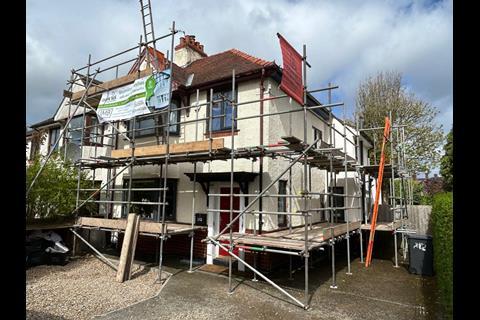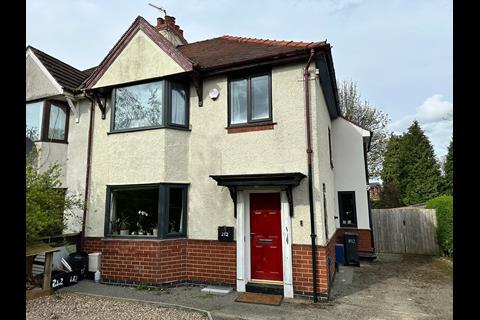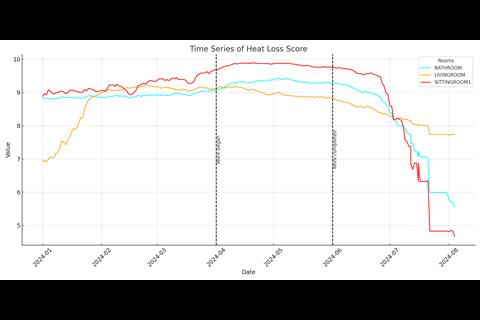The UK government is currently pouring billions of pounds into upgrading the country’s aging housing stock to meet modern energy efficiency standards. With the rising urgency to address climate change, retrofitting homes to reduce energy consumption is a key component of the UK’s strategy. However, the success of these energy efficiency upgrades depends heavily on accurate data validation
To ensure that retrofits yield real, measurable benefits, continuous monitoring of environmental factors within homes is essential. This is where Aico’s HomeLINK Connected Home Solution steps in, offering an innovative approach that empowers housing providers and residents with the insights they need to create healthier, more energy-efficient living spaces.
In this editorial, we explore how Aico’s cutting-edge technology has played a pivotal role in transforming a 1930s home in York, shedding light on the broader benefits of IoT-powered environmental monitoring in improving the UK’s housing stock.
Case Study: A York-Based Retrofit Transformation
The property at the centre of this case study is a semi-detached house in York, constructed in the 1930s with solid brick walls. Like many homes built during this period, the house was designed without the energy efficiency considerations we prioritise today. Its lack of insulation and cracked monocouche render on the rear extension resulted in significant heat loss, driving up energy consumption and costs.
To assess the property’s energy efficiency, an Energy Performance Certificate (EPC) was conducted. The results were concerning: the house earned a rating of D (60), which is below the government’s target of achieving at least a C rating for all homes by 2035. The EPC indicated that with proper interventions, the home could potentially reach a C rating (79), primarily by addressing its lack of insulation. But to ensure the most effective retrofit solutions were chosen, additional data was needed.
Understanding the Property Through Data
In addition to the EPC, Aico’s HomeLINK Environmental Sensors were installed 12 months prior to the retrofit intervention to capture detailed data about the property’s internal environment. These sensors, which collect temperature, humidity, and CO2 data at 15-minute intervals, gave a clearer picture of the home’s energy inefficiency.
The data revealed the root causes of the property’s poor energy performance. The average Time to Lose 1 Degree (TTL) of heat was just 28 minutes, meaning the home was losing heat rapidly across the three rooms monitored: the bathroom, family room, and green room. This TTL value can be used to compare heat loss between different properties, making it a valuable metric for identifying homes that need energy efficiency improvements. The data also pointed to a high risk of damp and mould, both of which are exacerbated by poor ventilation and contribute to an unhealthy living environment.
By utilising HomeLINK’s machine learning models, housing providers and residents can track how external temperatures affect internal heat retention and predict how quickly a room will lose heat. This level of insight enables data-driven decisions about which interventions will deliver the most impact.
The Retrofit Intervention: Introducing CorkSol
Given the findings from the EPC and environmental data, it was clear that the property’s walls were the primary source of heat loss. The original render was inefficient, and the solid brick construction offered little insulation. External wall insulation was the logical solution, but the design of the property posed a challenge. The first metre of the home’s exterior was exposed brickwork, and adding traditional insulation would not only cover this but also require all the windows to be removed and reinstalled.
To overcome these challenges, a more innovative approach was needed. The decision was made to use CorkSol, a cork-based render system that offered several advantages. Cork is a highly sustainable, natural material known for its excellent thermal performance. CorkSol’s exterior wall coatings are spray-applied in a thin layer, providing insulation without the need for thick insulation boards. The render is also water- and weather-resistant, offering a low-maintenance, eco-friendly solution.
CorkSol reduces heat loss by up to 30%, making it significantly more effective than traditional lime or sand renders. The application process was straightforward: the existing render was removed, cracks in the brickwork were repaired, and the new cork-based render was sprayed on. The entire installation was completed by JMB Plastering Specialists, an approved CorkSol UK applicator, within a few days.
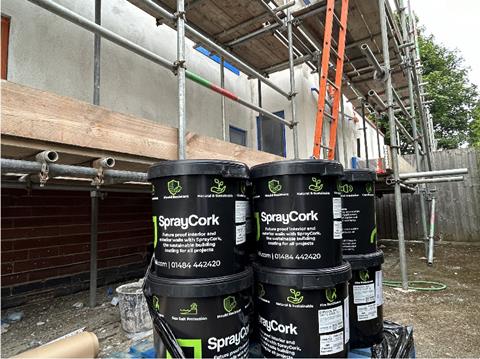
Data-Driven Results: Evaluating the Impact
Once the retrofit was complete, the property was monitored for two months using the same HomeLINK Environmental Sensors that had been installed before the intervention. The data revealed a dramatic improvement in the home’s energy efficiency. Heat loss risk had decreased from high across all three rooms to medium in two rooms and low in the third. Most impressively, the TTL had increased from 28 minutes to 53 minutes—a 25-minute improvement that signified a substantial reduction in heat loss.
This data-driven evaluation validated the effectiveness of the CorkSol solution. Without the use of Aico’s HomeLINK sensors, it would have been difficult to quantify the impact of the retrofit with such precision. As Daniel Little, Regional Director of Aico, points out: “Effective evaluation of retrofit interventions is imperative to validating a return on investment. Data will soon allow us to evaluate a property’s individual data and make recommendations on the most effective intervention. This will help maximize any investment made.”
Aico’s HomeLINK Connected Home Solution: The Power of IoT Monitoring
The success of the retrofit in York is just one example of how Aico’s HomeLINK Connected Home Solution is transforming homes across the UK. At the heart of the solution are Aico’s Ei1025 and Ei1020 Environmental Sensors, which monitor a range of environmental factors including air quality, temperature, humidity, and CO2 levels. These sensors are part of a larger Internet of Things (IoT) network that collects and analyses data in real time.
The data collected by the sensors is uploaded to the HomeLINK Portal, where it is processed by advanced algorithms. Homeowners and housing providers can access this data through an easy-to-use dashboard, which presents actionable insights into a property’s indoor environment. This level of visibility enables users to identify issues such as poor ventilation, high humidity levels, or elevated CO2 levels before they become serious problems. For example, high CO2 levels can indicate inadequate ventilation, which, if left unchecked, can lead to respiratory issues for occupants.
The HomeLINK Portal not only helps homeowners monitor energy efficiency but also tracks conditions that can lead to damp, mould, and other environmental hazards. By identifying these issues early, housing providers can take preventative action, reducing the need for costly repairs and creating healthier living conditions for residents.
Expert Support and Resident Engagement
Aico doesn’t just provide technology—it also offers a full range of support services to ensure that users get the most out of their HomeLINK system. Aico’s Customer Success Team works closely with housing providers and residents to help them understand the data collected by environmental sensors and take meaningful action. For instance, the team can assist in identifying patterns of heat loss or flagging high CO2 levels that may indicate poor ventilation.
Adam Taylor-Drake, Aico’s Head of Customer Success, underscores the importance of monitoring indoor conditions: “Environmental sensors can show damp and mould issues, if rooms are being heated and how often, therefore highlighting potential fuel poverty, as well as monitoring levels of Carbon Dioxide, which can have serious effects on occupants.”
In addition to this expert support, Aico offers a Connected Resident App that encourages residents to take an active role in managing their home’s environment. The app educates residents about indoor air quality, energy usage, and other factors that contribute to a healthy living space. It also facilitates direct communication between residents and housing providers, ensuring that issues are addressed quickly and efficiently.
A Growing Network of Connected Homes
Aico’s HomeLINK technology is already making a significant impact across the UK. With over 300,000 connected devices in homes across the country, Aico is helping to create a new standard for energy-efficient, healthy housing. The data generated by this vast network of sensors is not only improving individual homes but also providing housing providers with the insights they need to make smarter, more cost-effective decisions about maintenance and retrofitting.
The social housing sector, in particular, has embraced Aico’s HomeLINK solution. By reducing energy consumption, improving indoor air quality, and preventing costly repairs, Aico is helping landlords operate more efficiently while enhancing the quality of life for residents.
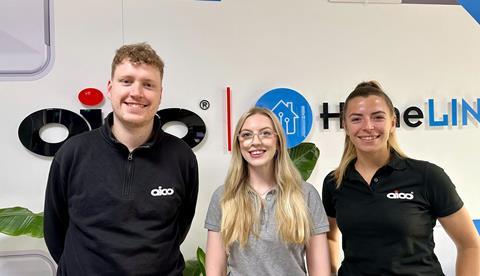
Investing in a Healthier, More Energy-Efficient Future
Fostering a healthy indoor environment is no longer an aspirational goal—it’s an achievable reality with Aico’s HomeLINK Connected Home Solution. By harnessing the power of IoT technology, homeowners and housing providers can create spaces that promote well-being, reduce energy consumption, and cut down on maintenance costs.
Investing in monitoring tools like Aico’s Environmental Sensors provides real-time insights into your home’s air quality and energy performance, enabling you to make informed decisions that enhance comfort and sustainability. Prioritising Indoor Air Quality is not just an investment in your health—it’s a commitment to creating a sustainable, efficient living space for future generations.
With Aico’s HomeLINK technology, the future of housing is connected, data-driven, and focused on creating healthier, more energy-efficient homes for all.




